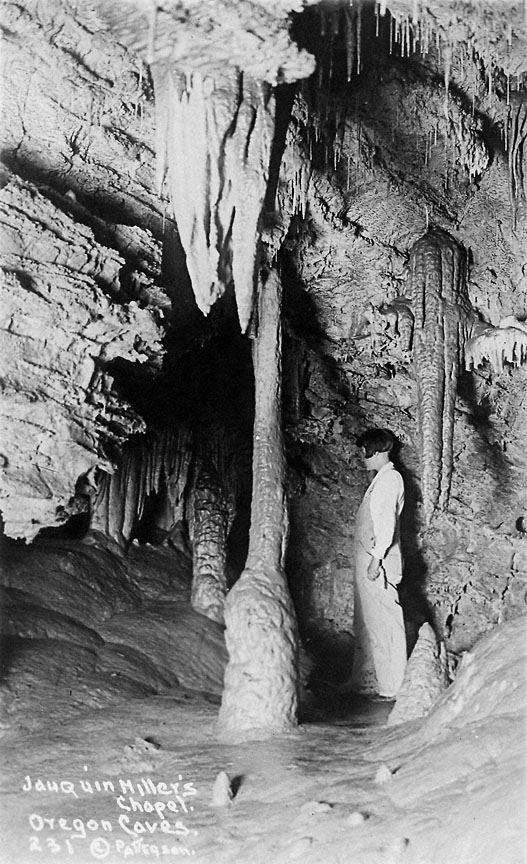- Catalog No. —
- Lot 981D119
- Date —
- circa 1920s
- Era —
- 1846-1880 (Treaties, Civil War, and Immigration), 1881-1920 (Industrialization and Progressive Reform), 1921-1949 (Great Depression and World War II), 1950-1980 (New Economy, Civil Rights, and Environmentalism), 1981-Present (Recent Oregon History)
- Themes —
- Environment and Natural Resources
- Credits —
- Oregon Historical Society
- Regions —
- Southwest
- Author —
- Frank Patterson
Joaquin Miller's Chapel, Oregon Caves
The Oregon Caves are a large system of caverns located high in the Siskiyou Mountains of southwestern Oregon. The complex consists of at least eleven caves which have formed in a marble section of the rock formation known as the Applegate Group. Over the millennia, flowing water has hollowed out the soft marble rock, resulting in one of the most elaborate cavern systems in the Pacific Northwest.
The first person known to have entered the caves was twenty-five-year-old Elijah J. Davidson, Jr., a local resident who was out hunting in the fall of 1874 when his dog ran into the caves to chase a bear. Davidson explored the caverns for three hours before he ran out of matches.
Davidson returned to the caves many times after his initial discovery, showing friends, family, and other curious locals the wondrous formations he had found. Though access was difficult, many parties made the journey to the caves during the last quarter of the nineteenth century. Many also took souvenirs of their trip, resulting in serious damage to some of the caves’ stalactites and stalagmites.
In 1909, President Teddy Roosevelt set aside the Oregon Caves as a national monument to prevent further vandalism. A road was built to the caves in 1922, which greatly facilitated access to the monument. Today, the Oregon Caves National Monument is one of southern Oregon’s most popular tourist destinations.
This photo of the caves was taken in the 1920s by the prolific postcard photographer Frank Patterson, who was based in Medford. It shows Joaquin Miller’s Chapel, a formation named after the famous “Poet of the Sierras.” After his visit to the area in 1907, Miller lobbied for protection of the caves, which he called the “Marble Halls of Oregon.”
Further Reading:
Contor, Roger J. “The Underworld of Oregon Caves National Monument.” Crater Lake Natural History Association, 1963.
Walsh, Frank K. “Discovery and exploration of the Oregon Caves.” Grants Pass, Oreg., 1971.
Sweet, Charles. “Discovery of the Oregon Caves.” Table Rock Sentinel 7, 1987: 3-8.
Written by Cain Allen, © Oregon Historical Society, 2003.
